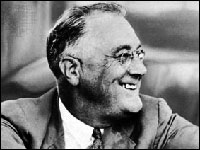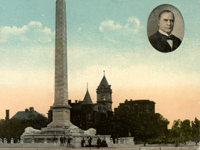The Cuban Missile Crisis: 40 Years Later
NBC Nightly News looks back at the Cuban Missile Crisis, showing how close America came to nuclear war with Russia in 1962.
The documentary clip may not appear on the first page.
NBC Nightly News looks back at the Cuban Missile Crisis, showing how close America came to nuclear war with Russia in 1962.
The documentary clip may not appear on the first page.
On the occasion of Eugene McCarthy's death, NBC explores the tumultuous year of 1968, when he challenged the Democrats to focus on Vietnam, the issue tearing the country apart.
This feature is no longer available.
Why is the exchange between Welch and McCarthy historically significant?
The granddaughter of Julius and Ethel Rosenberg discusses a documentary she has created for HBO that explores the question of whether they were really guilty.
On the eve of the Supreme Court's decision in Bush v. Gore, historian Doris Kearns Goodwin describes the controversy surrounding the 1876 contest between Rutherford Hayes and Samuel Tilden.
Author Walter Isaacson discusses the life of Benjamin Franklin and his many contributions to the prosperity of colonial Philadelphia and his place in American history.
The feature may not appear on the first page.
The Centre Hill Museum is a historic house museum. The 1823 residence is used to discuss its own history, including Presidential visits and its role in the Civil War. The interior houses decorative arts dating from 1700 through the 1900s. Collection highlights include a circa 1900 aviary of stuffed birds. The structure displays Greek Revival, Federal, and Colonial Revival elements.
The museum offers exhibits.
The Meridian International Center promotes international communication and understanding via diplomacy and leadership exchanges.
The center offers more than 50 traveling trunks available to DC educators via their international resource library. These trunks contain items relevant to particular foreign countries.

Offering more than 10,000 documents pertaining to Franklin D. Roosevelt's presidency, this website presents documents that include approximately 6,000 pieces of formerly-classified correspondence, reports, and memoranda. Topics include the Atlantic Charter; the United Nations; the Departments of War, Treasury, and State; and the Manhattan Project to develop the atom bomb.
The site also offers 1,000 documents pertaining to U.S.-Vatican relations during World War II, 2,000 documents concerning U.S.-German relations, and full texts of 30 "fireside chats." An exhibit examines "The Special Relationship" between Winston Churchill and Roosevelt and the emergence of an Anglo-American alliance. A mini-multimedia showcase contains one video clip of Roosevelt walking and 11 audio clips of speeches. The site also provides information on Eleanor Roosevelt and the Depression, and includes more than 2,000 photographs.

On September 14, 1901, American anarchist Leon Czolgosz assassinated President William McKinley, propelling Theodore Roosevelt onto the U.S. political stage and, some historians would argue, making way for political modernization. Through hundreds of documents and images—including book chapters, newspaper articles and columns, sermons, poetry, and government documents—this website explores the McKinley assassination alongside U.S. politics and culture before and after.
Topics include turn-of-the-century journalism, race relations, anarchism, women's roles, the death penalty, international relations, and the Pan-American Exposition in Buffalo, NY, where McKinley was shot. A good place to begin is the "Quotes About" section, which provides short excerpts from a variety of sources that serve to familiarize users with conflicting views of McKinley, Czolgosz, Roosevelt, the assassination, Czolgosz's trial, and anarchism in the United States. All documents are keyword searchable and indexed by date, author, title, type, named persons, and source. An extensive bibliography provides suggestions for further reading.